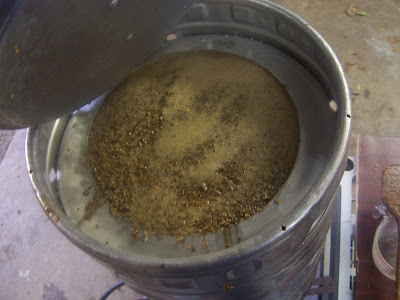
What do you do when you have the week off from work and not enough dough to fly home for the holidays? Brew! That's not all I've been up to, I've also been finding time to socialize, get out on some nice hikes, and clean up around the house. But on Christmas morning, it was all about throwing on some good tunes and brewing. After coffee of course.
This recipe is really the batch two of the "Wonton-amo Bay IPA" that I did in July. The first batch was one of the only beers I have ever made that had a diacetyl problem, and sadly I didn't recognize it in time to fix it. So this time around, I aim to make damn sure it's fully fermented before I crash it, but other than that it's fairly identical. Exact same malt bill, although it's lower O.G. due to slightly less efficiency an intentionally bigger final volume (I was aiming for 1.062ish so I was only a bit below target). Slightly higher mash temp. Very similar hop schedule, but some minor adjustments were made based on what I had in the freezer. I'm adding some Chinook and Citra to the dry hops in addition to what was added last time. Should be an all-out hop bomb, but also very clean, dry and drinkable. I've got high hopes that this one will redeem me from my last flawed attempt at IPA greatness.
Wonton-amo Bay IPA - Batch 2
Brewed on 12/25/10
Recipe is for 7 gallons pre-boil, 5.9 gallons post-boil, all grain
O.G. 1.060 F.G. 1.014 ABV 6.1% IBU's 87
10.5 lb. 2-row pale malt (Great Western Organic)
1 lb. wheat malt
.5 lb. Crystal 60
.5 lb. Carapils
19 gr. Warrior pellet 15.8%AA 60 min
20 gr. Summit whole 18%AA 30 min
36 gr. Amarillo whole 8.7%AA 10 min
14 gr. Citra whole 11%AA 10 min
6 gr. Chinook whole 14.2% 10 min
28 gr. Simcoe pellet 12.2% 0 min
28 gr. Centennial whole 7.8% 0 min
14 gr. Simcoe pellets dry hopped in the primary
14 gr. each: Centennial, Chinook, Citra, Simcoe, Amarillo, whole hops, dry hopped in the keg in a "sock".
Mash: 4.5 gallons water plus 3 tsp. Burton Salts
Mash in to 153 for 60 minutes, fell to 150.
Sparge with 5 gallons at 170
Collect 7 gallons at 1.050 = 79% efficiency
Boil 60 minutes, with hop additions as noted.
Added 1 tsp. Burton salts to kettle.
Wyeast nutrient and whirlfloc at 10 minutes.
Whirlpool, rest 10 minutes while setting up plate chiller.
Chill/transfer thru plate chiller over 10 minutes
Collect 5.5 gallons at 68 degrees.
Oxygen 60 seconds
Pitched 2 packages Wyeast 1056 Cali Ale Yeast
Ferment at 69
1/6/10 Primary dry hops added
1/18/10 Kegged, 1.014. Tastes and smells so freakin' good, not sure if it needs any extra hops but they were already in the keg. 2nd dry hop.














 All this together with some from-scratch creamed corn, mashed potatoes, cranberry sauce, green beens, and a zucchini dish made for an awesome feast.
All this together with some from-scratch creamed corn, mashed potatoes, cranberry sauce, green beens, and a zucchini dish made for an awesome feast. Well, in any case, it was a great opportunity to pair a food with the beer it was made from, since I also brought a growler of the Alt to drink. However, the best beers to drink with dinner were the
Well, in any case, it was a great opportunity to pair a food with the beer it was made from, since I also brought a growler of the Alt to drink. However, the best beers to drink with dinner were the 

































